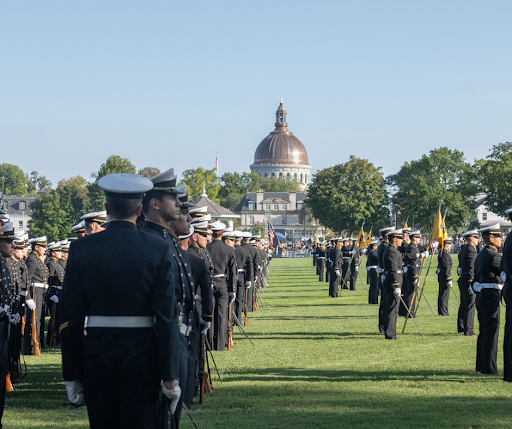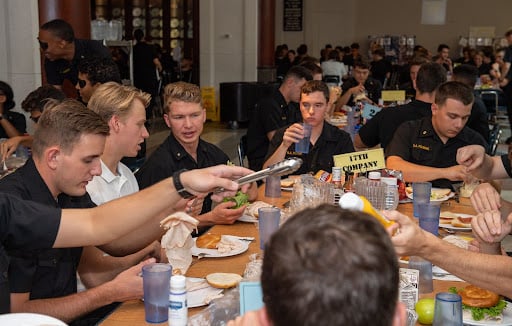
You may be familiar with famous bandmaster Charles A. Zimmerman, who composed and performed the U.S. Naval Academy anthem “Anchors Aweigh”—and you probably know one of USNA’s most famous graduates is Jimmy Carter. Still, the Yard is full of history, and these facts just scratch the surface.
Read on to find out more about the U.S. Naval Academy’s history: how the school came to be, what fascinating stories have happened in this hallowed place, and what recent events have helped shape the history of the ever-evolving U.S. Naval Academy:
- The School Started on Ships: As recently as 179 years ago, there was no Naval Academy. In 1825, President John Quincy Adams recommended to Congress that a naval school be established. At the time, navy sailors were educated onboard frigates, with each crew being taught by a schoolmaster. Both the attendance and the quality of education were subpar. So in 1839, a naval school was founded at the Philadelphia Naval Asylum. In 1842 the famous mathematician William Chauvenet became the head of the school, and on October 10, 1845, the Secretary of the Navy (also educator and historian), George Bancroft, founded the school in Maryland. He chose "the healthy and secluded" Annapolis in order to deter midshipmen from "the temptations and distractions that necessarily connect with a large and populous city."
Related: The U.S. Naval Academy’s Anniversary. - It All Began With a Plan for Mutiny: Why did Bancroft decide this? On September 13, 1842, the American brig USS Somers left the Brooklyn Navy Yard on a fateful cruise. It was one of the school’s ships that educated teenage naval apprentice volunteers, and it met a terrible end when Secretary of War John Canfield Spencer’s 19-year-old son, Midshipman Philip Spencer, was caught planning a mutiny with Boatswain Mate Samuel Cromwell and Seaman Elisha Small. A court of inquiry found them guilty, and all three were hanged on the yardarm (the spar that crosses the mast) on the high seas. The practice of school ships was brought under serious scrutiny, as the entire country reeled from the news.
- The War Changed Everything: When the Civil War broke out, Superintendent Captain George S. Blake moved the Naval Academy to a new home in Newport, Rhode Island, via the frigate USS Constitution, on April 25, 1861. Midshipmen, faculty, staff, the band, their families, the school library, and any classroom and laboratory equipment they could fit, were also brought up to Newport. The Academy conducted classes there through the war, returning after its end on August 9, 1865.
- Starting a Major Trend: The mechanical engineering course had its start at the U.S. Naval Academy in 1874. It was later adopted by other higher education institutions throughout the country and is a popular major across the country today.
- The Stone Cold Truth: Originally, Ernest Flagg, Academy architect, envisioned all buildings in red brick to continue the Annapolis style. However, two congressmen on the Naval Affairs Committee laid down an ultimatum—if they aren’t built of Maine granite, they said, Flagg wouldn’t get their vote. That’s why these awe-inspiring buildings sport this beautiful granite today.
- The Speed of Light Is Discovered: In June and July of 1879, professor and Naval Academy graduate Albert A. Michelson, Class of 1873, took just $10 of equipment up along the sea wall and accurately measured the speed of light. For this discovery, he was awarded the 1907 Nobel Prize in Physics, the first American (and USNA graduate) to earn one.
- Going for the Gold (and Navy): Until 1892, each class selected its own colors. That year, however, the school officially named navy and gold as the school colors of the USNA. The U.S. Naval Academy logo and all uniforms, spiritwear, and gear proudly show off these bold and rich colors to this day.
- Making It Official With a Seal: In 1898, Park Benjamin, Class of 1867, designed the U.S. Naval Academy’s official seal with the motto “Ex Scientia Tridens,” or “From Knowledge, Seapower.” Since 1906, this detailed seal has graced the front of every class ring, a part of USNA history.
Related: The Seal of the Naval Academy. - Cap It Off: After the graduation of 1912, the seniors threw their caps (called covers) into the air at the end of the ceremony, no longer needing them as they would now begin wearing an officer's cover, and a new and vibrant tradition was born. Now, other service academy graduates throw their caps up in a “hat toss” to celebrate their graduation. If you’re lucky, you’ll find a hat that was tossed with some money or a note tucked into the lining. Graduates often do this for the kids in the audience.
- Song of the Seas: The alma mater, “Navy Blue and Gold,” with verses by Lieutenant Roy Horn and music by Professor Joseph W. Crosley, was first performed at the inaugural Ring Dance, which occurred in 1925. An important part of USNA history, Ring Dances continue to this day. Second class midshipmen dip their rings in the waters of the Seven Seas and the Severn River to remind them of their four years spent together “where the Severn joins the sea.”
- Bringing in the Bands: At Noon Meal Formation, the music is played by one of three musical groups. The Naval Academy Band is the oldest band in the Navy and is composed of professional enlisted musicians. The Midshipman Drum and Bugle Corps, founded in 1914, is the oldest drum and bugle corps in the country. The Pipes and Drums are sponsored by the Class of 1961 submariners who served at Holy Loch, Scotland. These three talented groups also perform at the fall and spring parades held on Worden Field.
- Ringing in the Wins: When facing Bancroft Hall, you’ll see two large bells flanking her entrance. These are the “Victory Bells.” The left one replicates the Japanese Bell, which was cast in 1456 in Okinawa, Japan. Originally gifted to Commodore Matthew C. Perry in 1854, it was returned in 1987 when Okinawa’s governor asked that it be returned to replenish the many cultural treasures that had been lost during World War II. The U.S. sent the bell back and created a model in its place. Every time Navy beats Army in football, the Japanese Bell is rung. The team captain, coach, commandant, and superintendent ring the score of the game and each player gets a ring, too. On the right side of Bancroft Hall is the USS Enterprise Bell, brought here from the USS Enterprise, the most decorated ship in World War II. It is rung whenever Navy beats Army in varsity sports other than football.
- The Bill Stops Here: Where is BilI the Goat, you ask? We’ll never tell! He has been in the witness protection program since someone (likely cadets from the United States Military Academy West Point), took some of his ancestors before the 2012 Army-Navy football game. The debauchery goes back to 1953, when the Black Knights first goat-napped him. They’re the prime perpetrators of a series of goat-nappings, and the Zoomies of the U.S. Air Force Academy and the University of Maryland Terrapins have also joined in on the ruse.
Related: Oh! The Things You Can Learn on a USNA Walking Tour.
History is Happening Now
Those were just thirteen interesting tidbits of information, but USNA history happens every day. Come to the Yard and experience it yourself. Fascinating tours leave the Armel-Leftwich Visitor Center almost every hour, and you can even find a customized driving or walking tour that explores a specific theme, from the Anchors Aweigh Music Tour to the USNA Tour and Tea. You might even see a statue of your favorite midshipgoat on your travels. Every time you take a tour, eat on the Yard, shop at the shops, or simply visit, you’re giving back to the midshipmen, since our profits go directly to the Brigade to fund extracurricular activities like cultural arts, music, and theater, club sports and more. Want more fun USNA history? Find it here on the Yard.






